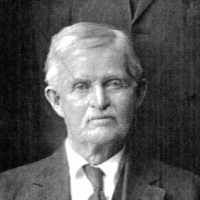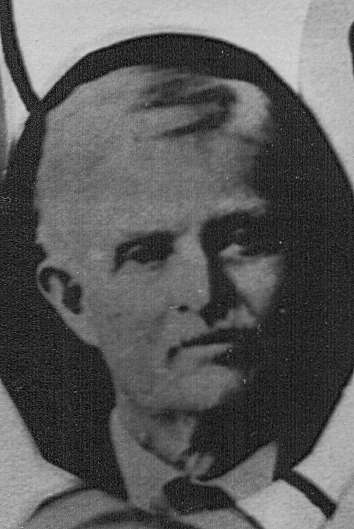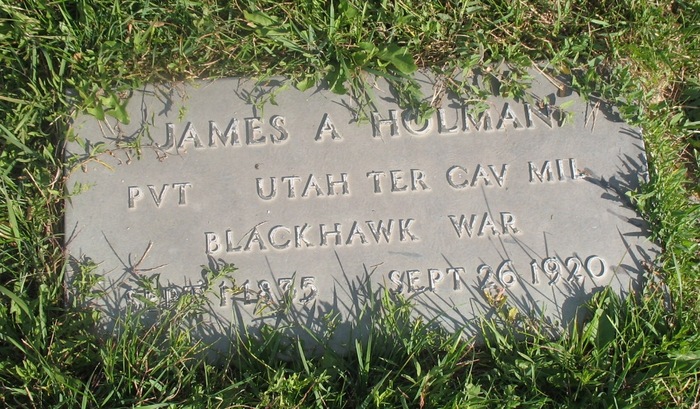This sense of responsibility came in good use for when the Saints were driven from Nauvoo and later to settle in Mount Pisgah, he was a big help. When his father was called to drive the sheep across the plains, James A. was left to be the man of the family and at the tender age of thirteen with his mother's help started their trip west in 1848 to the Salt Lake Valley. He had three yoke of oxen to drive. His father started back for them to help. They arrived in September or October safe and well, despite the hardships. There were seven children, the youngest under two.
The family remained in the Old Fort until the next spring when they moved to the north of Salt Lake. Here at Sessions, Davis County another sister arrived, Emma Jane. They built a home, fought the crickets, and survived.
In 1851 the family was called to go to Santaquin, in Utah County where they built the first home there. Because of Indian trouble the family moved back to Payson in 1853 and remained there until 1855 when they moved back to Santaquin. His father was made the first bishop there.
During this troubled time, James A. became indentified with the Indian troubles, being a minute man and a member of the cavalry. During the most strenuous of these times, horses were kept saddled and ready for the men to go at a moment's notice to the rescue of the settlers.
James A. did not move back to Santaquin with his family for he had met and married Sarah Ann Mathis of Payson and they remained in Payson until the following year. Then they moved to Santaquin where their first two babies were born.
The Indians at last became more friendly and peaceable through the valleys but in the outlying country they remained hostile and treacherous. The mail those days was carried on horseback or by stage. He was called to go with the New York Company to Wyoming to guard the mail route and was gone nearly a year.
Not only were they called to fight the Indians and guard the settlements but in 1858 when Johnston's Army, a division of the U.S. Army, came to Utah to kill of the Mormon people, the Militia hastened to meet them in Echo Canyon. It has been said that the militia stationed themselves on a knoll in the canyon, built bonfires and then spent the night marching about those fires. Their number was so few in comparison with the U.S. Army, that they knew that they must resort to some kind of strategy to frighten the soldiers. The soldiers watched the militia marching past the fires during the night never dreaming it was the same men who march just again and again. Thinking that the mountains were full of Mormons, the soldiers being very much alarmed and worried. Early the following morning the officer of the Militia appeared at the camp of the Commander of the Army and demanded that a certain amount of arms, ammunitions, and provisions be delivered to them. This the U.S. soldiers did, but very reluctantly, not knowing what else to do to save their lives. Many of them feared that they would be completely annihilated byt the Mormon Militia if they refused. The soldiers in this helpless condition were told to march down out of the mountains through the Salt Lake and to take up their quarters far beyond the borders of Salt Lake. Once again, the Saints were preserved by the hand of God and their enemies delivered into their hands.
James A. remained with the Army until 1867, taking part in all the Indian troubles.
He engaged in various enterprises. He took contracts for grading and building railroads, buildings, and running some mills and helping in many ways the development of the resources in this new country.
When the railroad was being built across the state, he made a trip to Helena, Montana with four double teams to bring back black powder that was used in the construction of the tunnels through Weber Canyon.
This tunnel was considered a wonder in railroad construction. James worked until the Union and Southern Pacific railroad construction were unified. He was present when the Golden Spike was driven. He spent much of his time freighting. Later he moved his family to Fountain Green where he engaged in farming and later in prospecting. Before they moved to Fountain Green they had lived in Pleasant Grove, across the street from Henson Walker's family. He lost his home there and so moved to Fountain Green where he and the boys could go into farming.
He was always thoughtful and considerate of others, being generous to a fault. He remained ambitious and enterprising and his mind remained clear and active. He was a great reader and was well informed. He was a High Priest at the time of his death. He died as he had lived — full of faith in the gospel, on the 24th of September, 1920, at the age of 85. He was the father of thirteen children and seventy-eight grandchildren.
This sense of responsibility came in good use for when the Saints were driven from Nauvoo and later to settle in Mount Pisgah, he was a big help. When his father was called to drive the sheep across the plains, James A. was left to be the man of the family and at the tender age of thirteen with his mother's help started their trip west in 1848 to the Salt Lake Valley. He had three yoke of oxen to drive. His father started back for them to help. They arrived in September or October safe and well, despite the hardships. There were seven children, the youngest under two.
The family remained in the Old Fort until the next spring when they moved to the north of Salt Lake. Here at Sessions, Davis County another sister arrived, Emma Jane. They built a home, fought the crickets, and survived.
In 1851 the family was called to go to Santaquin, in Utah County where they built the first home there. Because of Indian trouble the family moved back to Payson in 1853 and remained there until 1855 when they moved back to Santaquin. His father was made the first bishop there.
During this troubled time, James A. became indentified with the Indian troubles, being a minute man and a member of the cavalry. During the most strenuous of these times, horses were kept saddled and ready for the men to go at a moment's notice to the rescue of the settlers.
James A. did not move back to Santaquin with his family for he had met and married Sarah Ann Mathis of Payson and they remained in Payson until the following year. Then they moved to Santaquin where their first two babies were born.
The Indians at last became more friendly and peaceable through the valleys but in the outlying country they remained hostile and treacherous. The mail those days was carried on horseback or by stage. He was called to go with the New York Company to Wyoming to guard the mail route and was gone nearly a year.
Not only were they called to fight the Indians and guard the settlements but in 1858 when Johnston's Army, a division of the U.S. Army, came to Utah to kill of the Mormon people, the Militia hastened to meet them in Echo Canyon. It has been said that the militia stationed themselves on a knoll in the canyon, built bonfires and then spent the night marching about those fires. Their number was so few in comparison with the U.S. Army, that they knew that they must resort to some kind of strategy to frighten the soldiers. The soldiers watched the militia marching past the fires during the night never dreaming it was the same men who march just again and again. Thinking that the mountains were full of Mormons, the soldiers being very much alarmed and worried. Early the following morning the officer of the Militia appeared at the camp of the Commander of the Army and demanded that a certain amount of arms, ammunitions, and provisions be delivered to them. This the U.S. soldiers did, but very reluctantly, not knowing what else to do to save their lives. Many of them feared that they would be completely annihilated byt the Mormon Militia if they refused. The soldiers in this helpless condition were told to march down out of the mountains through the Salt Lake and to take up their quarters far beyond the borders of Salt Lake. Once again, the Saints were preserved by the hand of God and their enemies delivered into their hands.
James A. remained with the Army until 1867, taking part in all the Indian troubles.
He engaged in various enterprises. He took contracts for grading and building railroads, buildings, and running some mills and helping in many ways the development of the resources in this new country.
When the railroad was being built across the state, he made a trip to Helena, Montana with four double teams to bring back black powder that was used in the construction of the tunnels through Weber Canyon.
This tunnel was considered a wonder in railroad construction. James worked until the Union and Southern Pacific railroad construction were unified. He was present when the Golden Spike was driven. He spent much of his time freighting. Later he moved his family to Fountain Green where he engaged in farming and later in prospecting. Before they moved to Fountain Green they had lived in Pleasant Grove, across the street from Henson Walker's family. He lost his home there and so moved to Fountain Green where he and the boys could go into farming.
He was always thoughtful and considerate of others, being generous to a fault. He remained ambitious and enterprising and his mind remained clear and active. He was a great reader and was well informed. He was a High Priest at the time of his death. He died as he had lived — full of faith in the gospel, on the 24th of September, 1920, at the age of 85. He was the father of thirteen children and seventy-eight grandchildren.
Family Members
-
![]()
James Isaac Holman
1856–1940
-
![]()
Sarah J Holman Walker
1858–1939
-
![]()
John Alonzo Holman
1859–1935
-
![]()
David William Holman
1861–1929
-
Zilphia Ann Holman
1862–1866
-
Willard Franklin Holman
1865–1867
-
![]()
Nancy Melissa Holman Low
1866–1951
-
![]()
Parley Thomas Holman
1868–1944
-
![]()
Warren Mathis Holman
1871–1940
-
![]()
Martin Elmer Holman
1873–1896
-
![]()
Naomi Elizabeth Holman Huggins
1875–1940
-
![]()
Robert Ross Holman
1877–1950
-
![]()
Ezra Ray Holman
1879–1967
Sponsored by Ancestry
Advertisement
Records on Ancestry
Sponsored by Ancestry
Advertisement



























